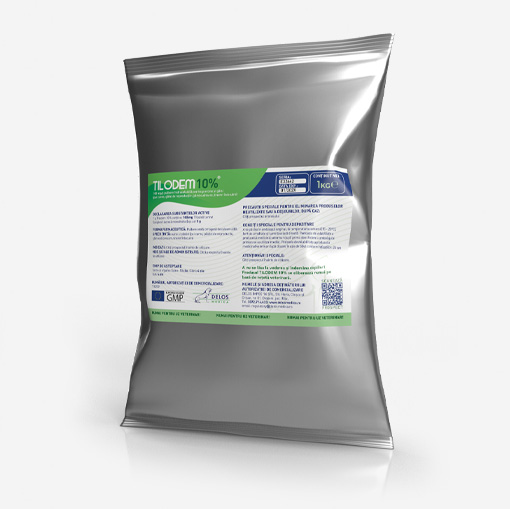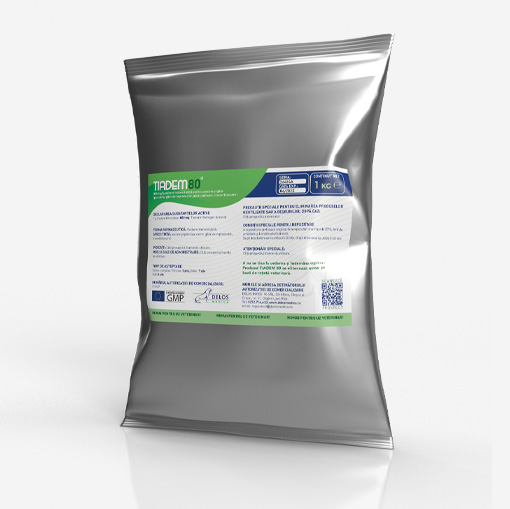|
|
|
Enrofloxacin 100 mg /ml.
|

ANTIBIOTIC
Enrodem 10%
Formula
Each ml of product contains:
Enrofloxacin (active substance 100 mg
Target species
Pigs, chickens.
Indications
Pigs: for the treatment of gastrointestinal, respiratory and urogenitaly infections produced by microorganisms susceptible to enrofloxacin: Gram Negative bacteria (Pseudomonas aeruginosa, Pasteurella spp, Salmonella spp, E.coli, Actinobacillus spp, Shigella spp., Klebsiella spp., Brachispira, Campylobacter spp.etc) Gram positive bacteria (Erysipelothrix rhusiopatiae, some strains of Streptococcus and Staphylococcus spp. etc), Mycoplasma spp., Brucella spp., Chlamydia.
Chickens
Treatment of infections caused by the following bacteria susceptible to enrofloxacin:
- Mycoplasma gallisepticum,
- Mycoplasma synoviae,
- Avibacterium paragallinarum,
- Pasteurella multocida
Administrare
In pigs: the product is administered via drinking water in dosage of 5 mg enrofloxacin/kg body weight/day, corresponding to 0.05 ml Enrodem 10% / kg body weight/day, for 5 consecutive days.
In chickens: 10 mg enrofloxacin/kg bodyweight per day (equivalent with 0.1 ml Enrodem 10%/kg bw/day) for 3-5 consecutive days.
Treatment for 3-5 consecutive days; for 5 consecutive days in mixed infections and chronic progressive forms. If no clinical improvement is achieved within 2-3 days, alternative antimicrobial therapy should be considered based on susceptibility testing.
The uptake of medicated water is dependant on the clinical condition of animals. In order to obtain the correct dosage, the concentration in drinking water may have to be adjusted.
For any information about this veterinary medicinal product, please contact the local representative of the Marketing Authorization Holder.
- Contraindications
- Side effects
- Storage
- Correct administration
- Withdrawal period
- Warnings
- Disposal
- Other information
Contraindications
Do not use for prophylaxis.
Do not use when resistance/ cross-resistance to (fluoro)quinolones is known to occur in the flock
intended for treatment.
Side effects
Locomotion disorders may occur as a result of damage of joint cartilage in case that fluoroquinolones are used during the growing period, particularly at higher temperatures, when consumption of medicated water is drastically increased for longer period.
Special precautions for storage
Keep away from reach and sight of children!
The product should be stored in original packaging at temperatures bellow 25oC, protected from direct sunlight and freeze.
Shelf life of the veterinary medicinal product as packaged for sale: 2 years.
Shelf life after dilution in drinking water, according to directions: 24 hours.
Shelf-life after first opening of package: 28 days. Close tight the recipient after every use.
Do not use after expiry date which is stated on the label.
Advice on correct administration
During treatment, the animals should drink only medicated water. Fresh medicated water should be prepared every 24 hours. To ensure a correct dosage, body weight should be determined as accurately as possible to avoid underdosing.
Withdrawal period
Meat and offal:
Pigs, chickens: 7 days.
Not for use in birds producing or intended to produce eggs for human consumption. Do not administer to layer replacement birds within 14 days of coming into lay.
Special warnings
Special warnings for each target species
The product must be diluted before administration to the animals.
Treatment of Mycoplasma spp. infections may not eradicate the organism.
Special precautions for use in animals
Fluoroquinolones should be reserved for the treatment of clinical conditions which have responded poorly, or are expected to respond poorly to other classes of antimicrobials.
Whenever possible, fluoroquinolones should be used based on susceptibility testing of the bacteria isolated from the animal. If this is not possible, therapy should be based on local (regional, farm level) epidemiological information about susceptibility of the target bacteria.
Use of the product deviating from the instructions given by the SPC may increase the prevalence of bacteria resistant to the fluoroquinolones and may decrease the effectiveness of treatment with other quinolones due to the potential for cross resistance.
Since enrofloxacin was first authorised for use in poultry, there has been widespread reduction in susceptibility of E.coli to fluoroquinolones and emergence of resistant organisms. Resistance has also been reported in Mycoplasma synoviae in the EU.
Special precautions to be taken by the person administering the medicinal product to animals
People with known hypersensitivity to any of the product ingredients should avoid contact with the veterinary medicinal product. Persons involved in the drug administration should wear special protection equipment (mask, eye protectors and rubber gloves). The direct contact of persons with enrofloxacin solution should be avoided, first of all concerning eyes, skin and clothing. In case of accidental exposure, wash any splashes from eyes with water; for skin exposure, wash with soap and water. Wash hands and exposed skin after use. In case of accidental ingestion or the occurrence of symptoms characterized by skin rash, seek medical advice. Serious symptoms such as swelling of face, lips or eye lids, accompanied by breath difficulties, need immediate medical attention.
Use during pregnancy, lactation and layering periods
Laboratory studies on rodents have not produced any evidence of teratogenic, fetotoxic or maternotoxic effects.
Interactions with other medicinal products
Antacid substances may interfere with gastrointestinal absorption of enrofloxacin.
In renal disorders treatment, nitrofurans administered concomitant with fluoroquinolones decreased therapeutically efficiency of fluoroquinolones.
Fluoroquinolones inhibits teophyline biotransformation leading to a high blood level and potentially toxic of teophyline.
“In vitro” enrofloxacin has synergic action to β-lactams, clindamicin and metronidazole.
The product should not be mixed with other drugs.
Overdose (symptoms, emergency procedures, antidotes)
In case of overdose the animals could show intolerance phenomena manifested as: vomit and diarrhea. Remove medicated water and institute the symptomatic therapy.
In poultry, daily treatment with dose 3 – 5 times higher than maximum recommended doses, for 15 consecutive days resulted in a reversible reduction of faecal consistency.
Incompatibilities
Do not administer together with nitro-furans because they decrease therapeutically effect of enrofloxacin.
Enrofloxacin is partial inactivated by hypochlorite compounds from drinking water (at concentration higher 5 mg/l).
Special precautions for the disposal of unused product or waste materials
For the environmental protection, medicines should not be disposed of via wastewater or household waste. Any unused veterinary medicinal product or waste materials derived from such veterinary medicinal products should be disposed of in accordance with local requirements.
Other information
PE-HD flasks of 100 ml, 500 ml, and 1000 ml.
PE-HD cans of 5 l, 10 l.
Not all pack sizes may be marketed.

Useful links
Important products
Delivering TRUST & QUALITY worldwide







